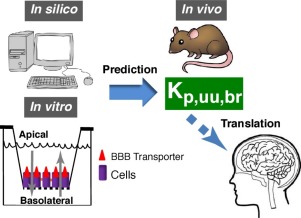Drug Discovery Today ( IF 7.4 ) Pub Date : 2018-03-13 , DOI: 10.1016/j.drudis.2018.03.002 Houfu Liu , Kelly Dong , Wandong Zhang , Scott G. Summerfield , Georg C. Terstappen

|
Recent years have seen a paradigm shift away from optimizing the brain:blood concentration ratio toward the more relevant brain:blood unbound concentration ratio (Kp,uu,br) in CNS drug discovery. Here, we review the recent developments in the in silico and in vitro model systems to predict the Kp,uu,br of discovery compounds with special emphasis on the in-vitro–in-vivo correlation. We also discuss clinical ‘translation’ of rodent Kp,uu,br and highlight the future directions for improvement in brain penetration prediction. Important in this regard are in silico Kp,uu,br models built on larger datasets of high quality, calibration and deeper understanding of experimental in vitro transporter systems, and better understanding of blood–brain barrier transporters and their in vivo relevance aside from P-gp and BCRP.
中文翻译:

使用计算机和体外模型系统预测CNS药物发现中的脑:血未结合浓度比
近年来,在CNS药物发现中,范式已从优化脑:血浓度比转向更相关的脑:血未结合浓度比(K p,uu,br)。在这里,我们回顾了计算机和体外模型系统的最新进展,以预测发现化合物的K p,uu,br,特别强调了体内-体外的相关性。我们还讨论了啮齿动物K p,uu,br的临床“翻译” ,并强调了改善脑部渗透预测的未来方向。在这方面,重要的是计算机K p,uu,br这些模型建立在更大的高质量数据集上,除了对P-gp和BCRP的了解外,还对实验性体外转运系统有更深入的了解,并对血脑屏障转运蛋白及其体内相关性有更好的了解。


























 京公网安备 11010802027423号
京公网安备 11010802027423号